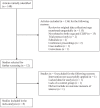Yoga for chronic low back pain: a meta-analysis of randomized controlled trials
- PMID: 23894731
- PMCID: PMC3805350
- DOI: 10.1155/2013/105919
Yoga for chronic low back pain: a meta-analysis of randomized controlled trials
Abstract
Objectives: To evaluate the efficacy of yoga as an intervention for chronic low back pain (CLBP) using a meta-analytical approach. Randomized controlled trials (RCTs) that examined pain and⁄or functional disability as treatment outcomes were included. Post-treatment and follow-up outcomes were assessed.
Methods: A comprehensive search of relevant electronic databases, from the time of their inception until November 2011, was conducted. Cohen's d effect sizes were calculated and entered in a random-effects model.
Results: Eight RCTs met the criteria for inclusion (eight assessing functional disability and five assessing pain) and involved a total of 743 patients. At post-treatment, yoga had a medium to large effect on functional disability (d=0.645) and pain (d=0.623). Despite a wide range of yoga styles and treatment durations, heterogeneity in post-treatment effect sizes was low. Follow-up effect sizes for functional disability and pain were smaller, but remained significant (d=0.397 and d=0.486, respectively); however, there was a moderate to high level of variability in these effect sizes.
Discussion: The results of the present study indicate that yoga may be an efficacious adjunctive treatment for CLBP. The strongest and most consistent evidence emerged for the short-term benefits of yoga on functional disability. However, before any definitive conclusions can be drawn, there are a number of methodological concerns that need to be addressed. In particular, it is recommended that future RCTs include an active control group to determine whether yoga has specific treatment effects and whether yoga offers any advantages over traditional exercise programs and other alternative therapies for CLBP.
OBJECTIFS :: Les chercheurs ont évalué l’efficacité du yoga comme intervention contre les douleurs lombaires chroniques (DLC) au moyen d’une approche méta-analytique. Ils ont inclus des essais aléatoires et contrôlés (EAC) qui portaient sur la douleur ou l’invalidité fonctionnelle comme issues du traitement. Ils ont évalué les issues après le traitement et au suivi.
MÉTHODOLOGIE :: Les chercheurs ont procédé à une recherche exhaustive des bases de données virtuelles pertinentes, à compter de leur création jusqu’à novembre 2011. Ils ont calculé les tailles d’effet d de Cohen et les ont saisies dans un modèle à effets aléatoires.
RÉSULTATS :: Huit EAC respectaient les critères d’inclusion (huit évaluant l’invalidité fonctionnelle et cinq, la douleur) et portaient sur un total de 743 patients. Après le traitement, le yoga avait un effet moyen à important sur l’invalidité fonctionnelle (d=0,645) et la douleur (d=0,623). Malgré un vaste éventail de styles de yoga et de durées de traitement, l’hétérogénéité des tailles d’effet après le traitement était faible. Les tailles d’effet de suivi étaient plus faibles sur le plan de l’invalidité fonctionnelle et de la douleur, mais demeuraient significatives (d=0,397 et d=0,486, respectivement). Cependant, le taux de variabilité de ces tailles d’effet était modéré à élevé.
EXPOSÉ :: Selon les résultats de la présente étude, le yoga peut être un traitement d’appoint efficace des DLC. Les données probantes les plus solides et les plus cohérentes faisaient foi des effets bénéfiques à court terme du yoga sur l’invalidité fonctionnelle. Cependant, avant de pouvoir tirer une conclusion définitive, il faudra régler un certain nombre de problèmes méthodologiques. Notamment, on recommande que les futurs EAC incluent un groupe de contrôle actif pour déterminer si le yoga avait des effets thérapeutiques précis et s’il comportait des avantages par rapport aux programmes d’exercice classiques et aux autres traitements de la DLC.
Figures
References
-
- Lim KL, Jacobs P, Klarenbach S. A population-based analysis of healthcare utilization of persons with back disorders: Results from the Canadian community health survey 2000–2001. Spine. 2006;31:212–8. - PubMed
-
- Andersson GBJ. Epidemiological features of chronic low-back pain. Lancet. 1999;354:581–5. - PubMed
-
- Balague F, Mannion AF, Fellise F, Cedraschi C. Non-specific low back pain. Lancet. 2012;379:482–91. - PubMed
-
- Linton SJ. A review of psychological risk factors in back and neck pain. Spine. 2000;25:1148–56. - PubMed
Publication types
MeSH terms
LinkOut - more resources
Full Text Sources
Other Literature Sources
Medical
Miscellaneous


